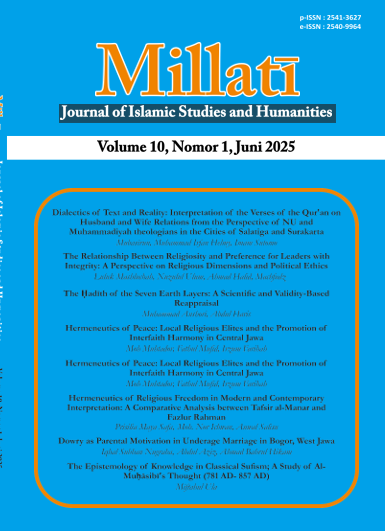Dowry as Parental Motivation in Underage Marriage in Bogor, West Java
DOI:
https://doi.org/10.18326/millati.v10i1.2686Keywords:
Underage marriage, Dowry, Parental MotivationAbstract
The study focuses on dowry as parental motivation in underage marriage in Bogor, with the main question being how the misinterpretation of the concept of birrul walidain (filial piety to parents) drives the practice. The background of the issue shows that social and economic pressures often reinforce the erroneous interpretation of this concept, where young girls are forced into early marriage as a form of obedience to their parents. The position of this research is to critique the misinterpretation and offer a new perspective on the understanding of birrul walidain in the context of child rights protection. The method used is qualitative, involving in-depth interviews with five victims of early marriage. The relevant theories in this analysis are feminist theory and child rights, which are used to understand how social and patriarchal structures exploit girls through religious doctrine. The research findings indicate that family pressure and the incorrect application of birrul walidain have restricted the victims' freedom, leading to a loss of educational opportunities and personal freedom. The main conclusion of this study emphasizes the need for reform in religious and social education to improve societal understanding of balanced duty, thereby protecting children's rights from exploitation in the form of early marriage.
References
Abdallah, Ahmed Saied Rahama, Mohammed Omar Musa Mohammed, and Adel Ali Ahmed Mohamed. “Early Marriage and Its Association with the Socioeconomic and Sociocultural Factors of Women in Sudan: A Predictive Model.” The Open Public Health Journal 16, no. 1 (2023): 1–7. https://doi.org/10.2174/18749445-v16-e230505-2022-167.
Abdurahman, Dureti, Nega Assefa, and Yemane Berhane. “Parents’ Intention toward Early Marriage of Their Adolescent Girls in Eastern Ethiopia: A Community-Based Cross-Sectional Study from a Social Norms Perspective.” Frontiers in Global Women’s Health 3 (2022). https://doi.org/10.3389/fgwh.2022.911648.
Ahyani, Hisam, Haris Maiza Putra, and Aji Sofanudin. “Birrul walidain in Political Preferences: Harmonizing Family Values and Employment Law in Indonesia.” El-Usrah 7, no. 2 (2024): 923–45. https://doi.org/10.22373/ujhk.v7i2.22982.
Angraeni, Kadek Noni, and Sri Lestari. “The Relationship of Adolescent Knowledge about the Risks of Early Marriage with the Desire to Engage in Early Marriage.” International Journal of Health Science and Technology 5, no. 2 (2023): 130–41. https://doi.org/10.31101/ijhst.v5i2.3253.
Banlanjo, Ngoran Mathew. “Cultural Pedogamy: Towards an Eco-Cultural Theory of Early (Child) Marriage.” European Journal of Humanities and Social Sciences 2, no. 6 (2022): 98–102. https://doi.org/10.24018/ejsocial.2022.2.6.334.
Bastiana, Bastiana, Abrar Abrar, and Reza H. Dynasti. “Unpacking Mutual Expectations in a Scavenger Family: A Case Study Investigating the Parent-Child Relationship.” Education Quarterly Reviews 7 (2024): 121–29. https://doi.org/10.31014/aior.1993.07.02.581.
Batool, Aqsa, Ruqia Safdar Bajwa, Sidra Farooq, and Muhammad Ayub. “The Impact of Marital Instability and Psychological Distress on Quality of Life among Married Women, Pakistan.” Pakistan Journal of Humanities and Social Sciences 11, no. 2 (2023): 2447–54. https://doi.org/10.52131/pjhss.2023.1102.0536.
Bawono, Yudho, Dewi Retno Suminar, Wiwin Hendriani, Universitas Airlangga Jl Airlangga No, Kecamatan Gubeng, Kota Surabaya, and Jawa Timur. “Low Education and Early Marriage in Madura: A Literature Review.” The Journal of Educational Development JED 7, no. 3 (2019): 166–72. http://journal.unnes.ac.id/sju/index.php/jed.
Boen, Courtney E., Karen Kozlowski, and Karolyn D. Tyson. “‘Toxic’ Schools? How School Exposures during Adolescence Influence Trajectories of Health through Young Adulthood.” SSM - Population Health 11 (2020). https://doi.org/10.1016/j.ssmph.2020.100623.
Bukido, Rosdalina, Chadijah Haris, Muhammad Arief Ridha Rosyadi, and Zulkarnain Suleman. “Reception of Marriage Age Limit in Marriage Law in Indonesia.” Samarah 7, no. 1 (2023): 146–74. https://doi.org/10.22373/sjhk.v7i1.15245.
Chen, Zefanya Angellin, Vanessa Vanessa, and Felicia Amanda Sulistio. “Case Studies on Marriage for Children Who Have Not Reached the Age Limit.” Aurella: Jurnal Penelitian Dan Pengabdian Masyarakat Indonesia 2, no. 2 (2023): 1167–74. https://doi.org/10.57235/aurelia.v2i2.672.
Dewi, Anak Agung Istri Ari Atu, Ni Ketut Supasti Dharmawan, Anak Agung Istri Eka Krisnayanti, Putu Aras Samsithawrati, and I. Gede Agus Kurniawan. “The Role of Human Rights and Customary Law to Prevent Early Childhood Marriage in Indonesia.” Sriwijaya Law Review 6, no. 2 (2022): 268–85. https://doi.org/10.28946/slrev.Vol6.Iss2.1885.pp268-285.
Downloads
Published
How to Cite
Issue
Section
License
Copyright (c) 2025 Abdul Aziz, Iqbal Subhan Nugraha, Ahmad Bahrul Hikam

This work is licensed under a Creative Commons Attribution-ShareAlike 4.0 International License.







